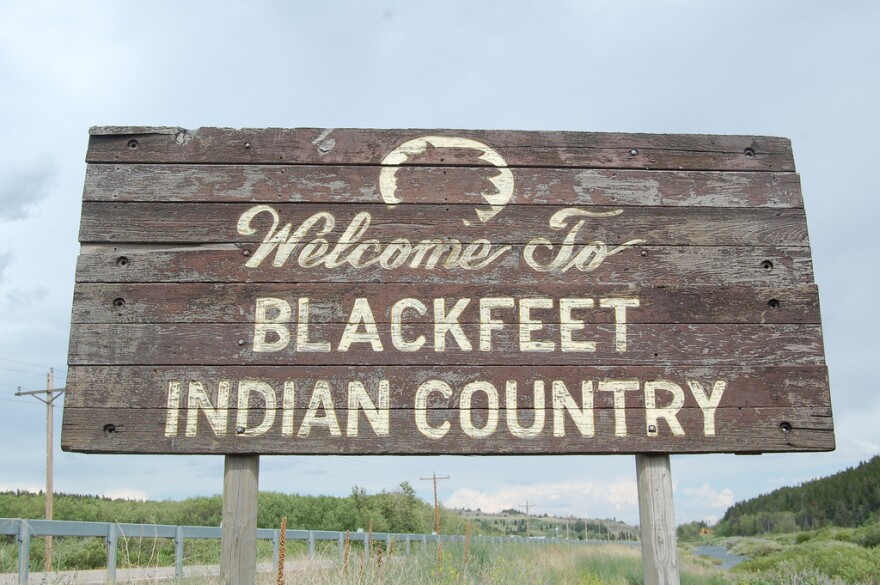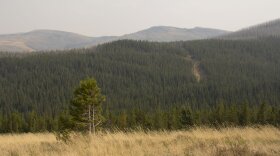U.S. Secretary of the Interior Sally Jewell visited Montana this week. She promised to change the future of the federal government’s relationship with Indian country.
"We hope that that says, let's bury the sins of the past, of which there were many, of the federal government in not upholding its trust and treaty obligations to the nation’s first people."
Standing on an elevated platform in front of about 100 tribal members, land conservation workers, and members of the media, Jewell announced that the federal Land Buy-Back Program is coming to the Blackfeet.
"I can’t think of a better place to be, nor a more wonderful group of people to be with today, than to be with you here, in the Blackfeet Nation to celebrate moving forward from a period of time in our history that presented many challenges. Challenges that we are not going to undue overnight, but we are certainly committed to undoing over time."
The Land Buy-Back Program is part of a legal settlement. Blackfeet tribal member Eloise Cobell launched the lawsuit in the 1990s charging the federal government with mismanaging Indian funds held in trust by the federal government.
The program attempts to correct an unintended consequence of the 19th century Allotment Act. That act gave individual Native Americans allotments of land of a few hundred acres. When the landowner died, land ownership passed to their children.
Blackfeet Business Council Chairman Harry Barnes says old law created problems for native communities all across the country.
"The goal of the Allotment Act was to create individual Indians, thereby eliminating the need for a tribe. But they didn’t realize the mess they created, because the inheritance laws are such that if a person doesn’t have a will, then [the land] is equally split. So now we have one-acre lots that get a hundred names on it."
As generations passed and families divided into new families the land continued to divide in ownership.
When a single tract of land is owned by many people, effective development and management on the land becomes difficult, sometimes impossible.
"We're the third most fractionated tribe in the country."
Bill Old Chief, Jr. coordinates the 10 staff running the Blackfeet Land-Buy Back program. He says of the 17,000 Blackfeet tribal members, more than 7,000 could receive offers to buy up their fractional ownership in the land.
That could result in more than three quarters of a million acres transferred into Blackfeet tribal control from individual members.
"It is completely voluntary. No one is being forced to sell. What we have looked at on other reservations is that it is about 50 percent. I mean out of the 100 percent of offers that go out, about 50 percent are willing to sell."
Old Chief, Jr. says the Blackfeet are the last tribe in Montana to start using the Land Buy-Back Program.
In order to educate tribal members about the Land Buy-Back Program, Old Chief Jr. says his team will be hosting monthly events in Browning, Heart Butte, Seville, Starr, and Babb. They’ll also head to Washington State later this summer to reach out to Blackfeet members living there.

The Blackfeet entered into the Land Buy-Back Program in March, and the program allows the tribe a year of administrative funds to complete the program.
Old Chief, Jr. says his team will send out flyers and hold events all spring and summer, until the land buy-back offers go out this fall.
"I think it will alleviate some of the problems, but I don't think it will completely get rid of the entire fractionalization. You know, I have land and I’m going back and forth right now, as far as if I do get an offer on it, if I’m going to sell. My son, he is going to be 13 here in a week, and he wants to own land."
Old Chief, Jr. raises a concern that he expects other Blackfeet will have too.
He has partial ownership in about 25 pieces of land. He wanted to build a house on one of them, but he couldn't because he couldn’t get permission from all of the other partial landowners.
But even if a some tribal members have trouble building on the land, Old Chief, Jr. says some will still hold onto their fractional ownership of the land, only for the sentimental value. Even if the land lies idle, it is still something passed down from one generation to next.
The Cobell Settlement that created the Land Buy-Back Program amounted to almost $3.5 billion, and is the largest class action settlement against the federal government.
Learn more about the Land Buy-Back Program here.
Wind Dancer Tunes helped gather the audio for this story.





